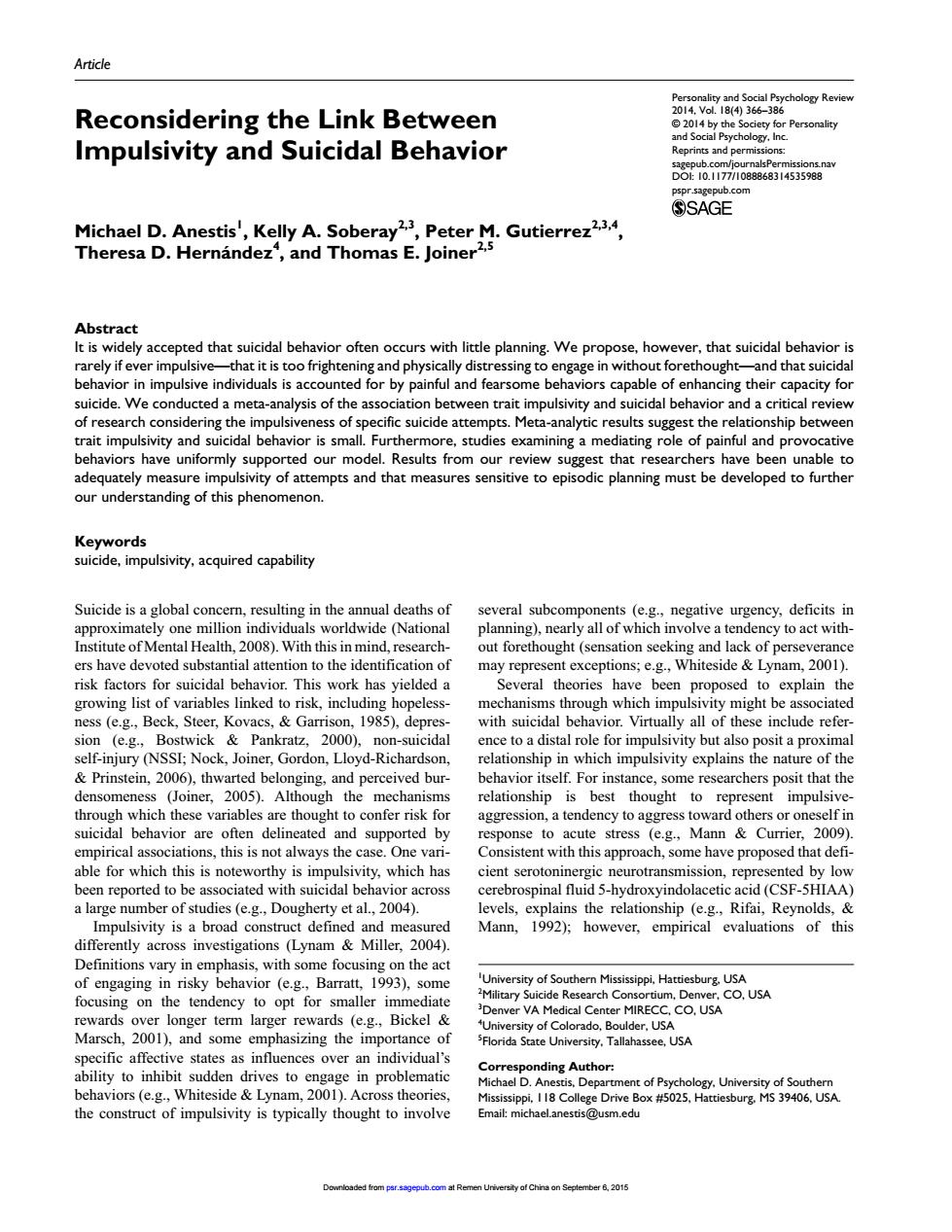正在加载图片...

Article Reconsidering the Link Between Impulsivity and Suicidal Behavior SAGE MichaelD.Anestis'Kelly A.Soberay Peter M.Gutierrez Theresa D.Hernandez,and Thomas E.Joiner Abstrac It is widely accepted that suicidal behavior often occurs with little planning.We propose,however,that suicidal behavior i r by p ors capa enn of research considerine the im ts metaanalytic results su trait impulsivity and suicidal behavior is small Furthermore,studies examining a mediating role of painful and provocative review sugest that resear e bee y9 mpts and that measures sensitive to epis pulsivity.acquired capability Suicide is a global concern,resulting in the annual deaths of several subcompo nents (e.g..negative urgency.deficits in approximately one million individua )( planning),nearly all of which involve a tendency to act with ute of Me in mind,rese out forethought(sensation s wg and I perse ha wing list of variables linked to risk,including hopeless 1985),depre vith suicidal be avior.Virtually all of these include refer 10 (e.g. atz Don-su cnce to a c of th Prinstein,2006).thwarted belor and perceived bur For instance.ome researhers posit that the densomeness (oiner.2005).Although the mechanisms elationship is best thought to represent impulsive through which these va ggression,a ter ard othe f with thi d that def able for which this is noter orthy is impulsivity.which has sient serotoninergie neurotransmission re ented by lov ociated with suicidal be avior across erebrospinal fluid 5-hydroxyindolacetic acid(CSF-5HIAA a large of st (e.g.,Dough eny et al 2004) Mann. of thi 2004 Definitions vary in emphasis,with some focusing on the act of engaging risky behavior (e.g. Barratt.193),son Co CO.USA opt IRECC.CO.USA Marsch.2001).and some emphasizing the imp e of cific affective states as influences over an individual's sudden ves to in problemati ors (e.g 2001 he tiesburg MS 39406.USA of ir Personality and Social Psychology Review 2014, Vol. 18(4) 366–386 © 2014 by the Society for Personality and Social Psychology, Inc. Reprints and permissions: sagepub.com/journalsPermissions.nav DOI: 10.1177/1088868314535988 pspr.sagepub.com Article Suicide is a global concern, resulting in the annual deaths of approximately one million individuals worldwide (National Institute of Mental Health, 2008). With this in mind, researchers have devoted substantial attention to the identification of risk factors for suicidal behavior. This work has yielded a growing list of variables linked to risk, including hopelessness (e.g., Beck, Steer, Kovacs, & Garrison, 1985), depression (e.g., Bostwick & Pankratz, 2000), non-suicidal self-injury (NSSI; Nock, Joiner, Gordon, Lloyd-Richardson, & Prinstein, 2006), thwarted belonging, and perceived burdensomeness (Joiner, 2005). Although the mechanisms through which these variables are thought to confer risk for suicidal behavior are often delineated and supported by empirical associations, this is not always the case. One variable for which this is noteworthy is impulsivity, which has been reported to be associated with suicidal behavior across a large number of studies (e.g., Dougherty et al., 2004). Impulsivity is a broad construct defined and measured differently across investigations (Lynam & Miller, 2004). Definitions vary in emphasis, with some focusing on the act of engaging in risky behavior (e.g., Barratt, 1993), some focusing on the tendency to opt for smaller immediate rewards over longer term larger rewards (e.g., Bickel & Marsch, 2001), and some emphasizing the importance of specific affective states as influences over an individual’s ability to inhibit sudden drives to engage in problematic behaviors (e.g., Whiteside & Lynam, 2001). Across theories, the construct of impulsivity is typically thought to involve several subcomponents (e.g., negative urgency, deficits in planning), nearly all of which involve a tendency to act without forethought (sensation seeking and lack of perseverance may represent exceptions; e.g., Whiteside & Lynam, 2001). Several theories have been proposed to explain the mechanisms through which impulsivity might be associated with suicidal behavior. Virtually all of these include reference to a distal role for impulsivity but also posit a proximal relationship in which impulsivity explains the nature of the behavior itself. For instance, some researchers posit that the relationship is best thought to represent impulsiveaggression, a tendency to aggress toward others or oneself in response to acute stress (e.g., Mann & Currier, 2009). Consistent with this approach, some have proposed that deficient serotoninergic neurotransmission, represented by low cerebrospinal fluid 5-hydroxyindolacetic acid (CSF-5HIAA) levels, explains the relationship (e.g., Rifai, Reynolds, & Mann, 1992); however, empirical evaluations of this 535988 PSRXXX10.1177/1088868314535988Personality and Social Psychology ReviewAnestis et al. research-article2014 1 University of Southern Mississippi, Hattiesburg, USA 2 Military Suicide Research Consortium, Denver, CO, USA 3 Denver VA Medical Center MIRECC, CO, USA 4 University of Colorado, Boulder, USA 5 Florida State University, Tallahassee, USA Corresponding Author: Michael D. Anestis, Department of Psychology, University of Southern Mississippi, 118 College Drive Box #5025, Hattiesburg, MS 39406, USA. Email: michael.anestis@usm.edu Reconsidering the Link Between Impulsivity and Suicidal Behavior Michael D. Anestis1 , Kelly A. Soberay2,3, Peter M. Gutierrez2,3,4, Theresa D. Hernández4 , and Thomas E. Joiner2,5 Abstract It is widely accepted that suicidal behavior often occurs with little planning. We propose, however, that suicidal behavior is rarely if ever impulsive—that it is too frightening and physically distressing to engage in without forethought—and that suicidal behavior in impulsive individuals is accounted for by painful and fearsome behaviors capable of enhancing their capacity for suicide. We conducted a meta-analysis of the association between trait impulsivity and suicidal behavior and a critical review of research considering the impulsiveness of specific suicide attempts. Meta-analytic results suggest the relationship between trait impulsivity and suicidal behavior is small. Furthermore, studies examining a mediating role of painful and provocative behaviors have uniformly supported our model. Results from our review suggest that researchers have been unable to adequately measure impulsivity of attempts and that measures sensitive to episodic planning must be developed to further our understanding of this phenomenon. Keywords suicide, impulsivity, acquired capability Downloaded from psr.sagepub.com at Remen University of China on September 6, 2015